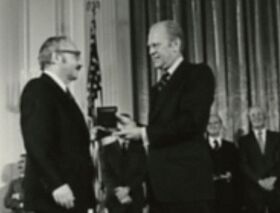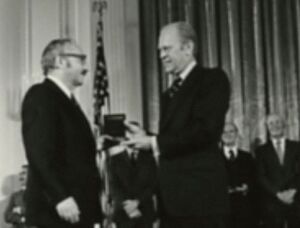George Dantzig facts for kids
Quick facts for kids
George Dantzig
|
|
|---|---|

Dantzig with President Gerald Ford in 1976
|
|
| Born |
George Bernard Dantzig
November 8, 1914 Portland, Oregon, US
|
| Died | May 13, 2005 (aged 90) |
| Alma mater | University of Maryland (BS) University of Michigan (MS) University of California, Berkeley (PhD) |
| Known for | Linear programming Quadratic programming Stochastic programming Linear complementarity problem Max-flow min-cut theorem of networks Pseudoforest Vehicle routing problem Dantzig's simplex algorithm Dantzig–Wolfe decomposition |
| Awards | John von Neumann Theory Prize (1975) National Medal of Science (1975) Harvey Prize (1985) Harold Pender Award (1995) |
| Scientific career | |
| Fields | Mathematics Operations research Industrial engineering Computer science Economics Statistics |
| Institutions | U.S. Air Force Office of Statistical Control RAND Corporation University of California, Berkeley Stanford University |
| Doctoral advisor | Jerzy Neyman |
| Doctoral students | Robert Fourer Alfredo Noel Iusem Ellis L. Johnson Thomas Magnanti Roger J-B Wets Yinyu Ye |
George Bernard Dantzig (born November 8, 1914 – died May 13, 2005) was an American scientist. He made big contributions to mathematics, computer science, and economics.
Dantzig is famous for creating the simplex algorithm. This is a special method for solving linear programming problems. These problems help find the best way to do things, like planning or scheduling.
He also solved two very difficult problems in statistics. He thought they were just homework problems for a class! This story became very famous.
At the time of his death, Dantzig was a professor at Stanford University. He taught about transportation science and computer science.
Contents
Early Life and Family
George Bernard Dantzig was born in Portland, Oregon. He was named after a famous Irish writer, George Bernard Shaw. His parents were Jewish. His father, Tobias Dantzig, was a mathematician and linguist. His mother, Anja Dantzig, was also a linguist. She was from Russia.
Dantzig's parents met while studying in Paris, France. His father studied math there. The Dantzig family later moved to the United States. In the early 1920s, they moved to Washington, D.C.. His mother worked at the Library of Congress. His father taught math at the University of Maryland, College Park.
Education and the Famous Homework
Dantzig went to Powell Junior High School and Central High School. He loved geometry from a young age. His father often gave him challenging math problems to solve.
He earned his first degree in math and physics from the University of Maryland in 1936. Then, he got his master's degree in math from the University of Michigan in 1937. After working for a few years, he started his PhD in mathematics at the University of California, Berkeley. There, he studied statistics.
In 1939, something amazing happened. Dantzig arrived late to a class taught by Professor Jerzy Neyman. He saw two problems written on the blackboard. He thought they were homework assignments. He worked on them for a few days. He found them "a little harder than usual" but solved both.
Six weeks later, Professor Neyman told him the exciting news. The "homework" problems Dantzig had solved were actually two of the most famous unsolved problems in statistics! This story spread and became an inspiring example of positive thinking. It even appeared in the movie Good Will Hunting.
Dantzig later said that Professor Neyman accepted these two solutions as his PhD thesis. Another researcher, Abraham Wald, had also worked on one of these problems. When he found out about Dantzig's solution, he added Dantzig's name as a co-author on his paper.
Career and Contributions
During World War II, Dantzig took a break from his studies. He worked for the United States Army Air Forces. From 1941 to 1946, he led a team that analyzed combat data.
In 1946, he finished his PhD at Berkeley. He then returned to the Air Force as a math advisor. In 1952, Dantzig joined the RAND Corporation. This was a research organization.
By 1960, he became a professor at the University of California, Berkeley. He started and led the Operations Research Center there. In 1966, he moved to Stanford University. He became a professor of Operations Research and Computer Science. He also founded the Systems Optimization Laboratory (SOL) at Stanford.
Dantzig received many awards for his work. These include the first John von Neumann Theory Prize in 1974. He also received the National Medal of Science in 1975. The Mathematical Programming Society created the George B. Dantzig Prize in his honor. This award is given every three years to people who make a big impact in mathematical programming.
What is Linear Programming?
Dantzig's research greatly helped the field of linear programming. This is a math method used to find the best possible outcome. For example, it can help find the most profit or the lowest cost. It works by using mathematical models with linear relationships.
Linear programming was first developed during World War II. It helped the army plan how to spend money and reduce costs. After the war, many industries started using it for their daily planning.
Dantzig's work helps airlines schedule their crews and planes. Shipping companies use it to decide how many trucks they need. The oil industry uses it to plan how to turn crude oil into different types of gasoline. It is also used in manufacturing, advertising, and many other areas.
One of Dantzig's first examples showed how useful linear programming is. He found the best way to assign 70 people to 70 different jobs. Trying every possible combination would take an incredibly long time. But by using linear programming and the Simplex algorithm, the best solution can be found very quickly.
In 1963, Dantzig's book Linear Programming and Extensions was published. It quickly became a very important book in the field.
Personal Life
Dantzig married Anne S. Shmuner in 1936. He passed away on May 13, 2005, at his home in Stanford, California. He was 90 years old. He died from problems related to diabetes and heart disease.
Presidential Award
On October 18, 1976, President Gerald Ford gave Dantzig the President's National Medal of Science. This award recognized him for inventing linear programming. It also honored his methods that led to wide-scale uses in planning, scheduling, and using computers to solve complex problems.
See also
 In Spanish: George Dantzig para niños
In Spanish: George Dantzig para niños
- Dantzig–Wolfe decomposition
- Knapsack problem
- Maximum flow problem
- Optimization (mathematics)
- Travelling salesman problem
- Shadow price
- List of Jewish American mathematicians


